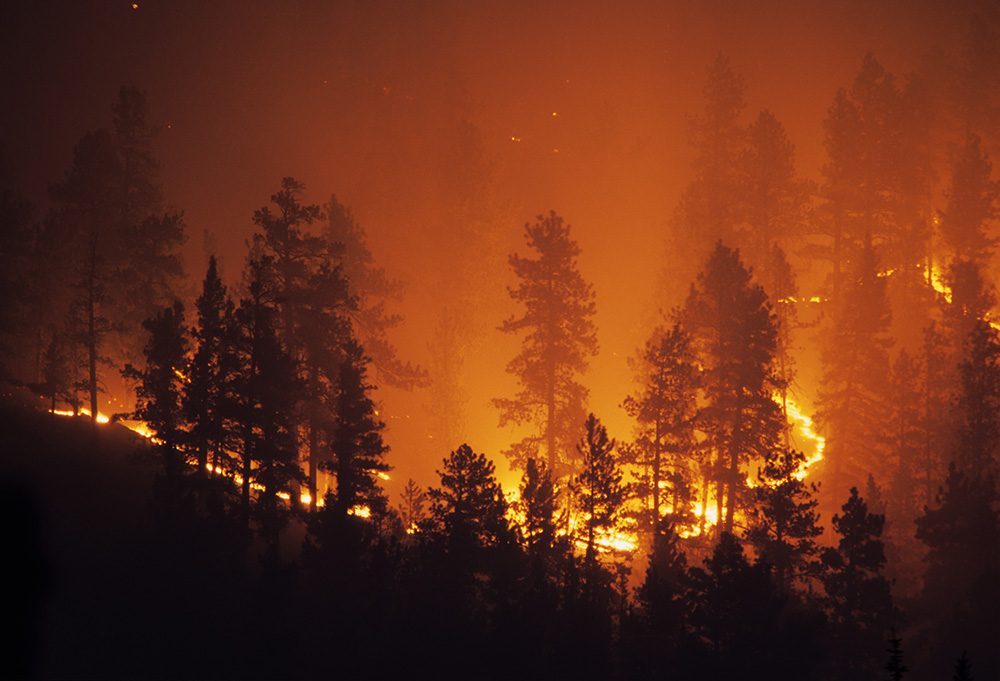Public Safety Canada reports that the area burned by wildfires in Canada so far this year is already the second largest on record: 3.7 million hectares. The 10-year average for wildfire seasons is about 800,000 hectares. Wildfire season typically starts in April, hits its peak in July and ends in October, but research now shows a shift to longer fire seasons as climate change effects continue.
Wildfires typically start either from natural sources, (lightning is most common) or from human activity such as dropping a lit cigarette or letting a campfire smolder. Natural conditions that make it more likely for a wildfire to start also increase the risk. For instance, May and June are prime times for wildfires to begin as grass, twigs and branches that have dried up over the winter become ‘fuel on the ground’.
A forest fire can travel up to 10.8 km/h in most environments, or up to 22 km/h in grasslands. Many factors affect how quickly a fire will travel, including wind strength and direction, how dry the area is, and what fuel is available for the fire to consume.
Natural Causes of Wildfires
Natural wildfires are almost always caused by lightning, though in rare instances, volcanoes, meteors, and coal seams can also be a cause. Lightning is especially dangerous, as it can ignite wildfires anywhere, including remote, hard-to-access areas. Lightning is also usually accompanied by strong thunderstorm winds that can turn a spark into a raging fire.
Human Causes of Wildfires
Statistics vary from province to province, but most indicate that 40 to 50 percent of wildfires in Canada are caused by people. Human-caused wildfires can be classified into unintentional/irresponsible and intentional fires. Some unintentional/irresponsible causes can include:
- Campfires or debris piles burning out of control
- Campfires or debris fires being left unattended before they are completely extinguished
- Discarded lit cigarettes
- Sparks from machinery and industrial equipment
- Fireworks and other pyrotechnic devices
Lesser-known causes of wildfires
While they are less well-known, here are a few other common causes of forest fires:
- Discarded glass: Throwing a glass bottle on the side of the road can create a fire hazard as the curved glass can refract sunlight, like a magnifying glass. This can ignite dry grass and start a fire.
- Spontaneous combustion: Usually caused by improper storage of substances with low ignition temperatures, like hay, straw and peat. Stored in large quantities, heat created by bacteria or oxidization can build up and lead to spontaneous combustion.
- Electrical malfunctions: Faulty or fallen power lines can spark and ignite nearby vegetation.
Intentional causes of wildfires
Incendiary or intentional causes of wildfire include arson and illegal or unauthorized burning. If a person intentionally sets a forest fire, it qualifies as arson— an indictable offence.
How Can I Protect My Property From Wildfires?
Wildfires are hard to predict and control, but there are some preventive steps that you can take to protect your property:
- Remove combustible vegetation close to your home.
- Move firewood away from home.
- Clear out gutters of twigs and leaves.
- Ensure your roof uses class A fire-rating materials.
- Keep a sprinkler in good working condition and within easy access.
- Ensure your deck is fire-resistant.
- Replace single-pane windows for more heat protection.
- Have functioning smoke detectors on every level of your home.
Recover From Wildfire Damage To Your Property
In the unfortunate event that your home does experience damage caused by wildfire, the fire damage restoration experts at ServiceMaster Restore can help you through crisis resolution in the shortest time possible.
Our team is backed by over 70 years of experience in fire damage remediation, and we will work with you to get your life back to normal as quickly as possible.
Helpful Resources
Knowing if your area is vulnerable to wildfires, and where and how they are likely to start in your region, can help you be better prepared. You can access monthly and seasonal forecast maps of fire weather in regions across Canada at the following links:
https://cwfis.cfs.nrcan.gc.ca/maps/forecasts?type=fsa&month=04
https://cwfis.cfs.nrcan.gc.ca/interactive-map

